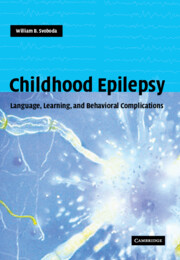Book contents
- Frontmatter
- Contents
- Preface
- Glossary
- 1 Looking ahead
- Part I Speech and language problems
- Part II Learning problems
- Part III Behavior problems
- 27 Mental health needs
- 28 Psychologic development
- 29 Seizure types and modifying factors
- 30 Overview: extrinsic factors
- 31 Behavior problems: general
- 32 Attention deficit disorders
- 33 Anxiety disorders
- 34 Mood disorders
- 35 Disruptive behavior problems
- 36 Psychoses of epilepsy
- 37 Non-epileptic events
- 38 Possible treatment issues
- 39 Helping with psychiatric problems
- 40 Epilog
- Index
- References
29 - Seizure types and modifying factors
from Part III - Behavior problems
Published online by Cambridge University Press: 26 October 2009
- Frontmatter
- Contents
- Preface
- Glossary
- 1 Looking ahead
- Part I Speech and language problems
- Part II Learning problems
- Part III Behavior problems
- 27 Mental health needs
- 28 Psychologic development
- 29 Seizure types and modifying factors
- 30 Overview: extrinsic factors
- 31 Behavior problems: general
- 32 Attention deficit disorders
- 33 Anxiety disorders
- 34 Mood disorders
- 35 Disruptive behavior problems
- 36 Psychoses of epilepsy
- 37 Non-epileptic events
- 38 Possible treatment issues
- 39 Helping with psychiatric problems
- 40 Epilog
- Index
- References
Summary
In children, a relationship between neuropsychological functioning and psychopathology exists. Children with impaired cognition tend to be more aggressive and have more mental disorders but show less social competency than children who are neurologically intact (Hermann, 1982). Pathology of the limbic system rather than complex partial seizures appears to be the more significant factor in predisposing patients with seizures to psychopathology. Both the psychopathology and seizure disorders appear to arise from cerebral damage rather than from the seizures themselves (Stevens & Hermann, 1981).
Neurologic basis of ictal behavior
Two things happen in seizures: some discharges activate behaviors and some discharges interfere with behavior processes (Gloor, 1986). The type of behaviors manifest relates to the area of the brain involved in the discharge. The temporal lobe, especially the limbic portion, i.e. the hippocampus and amygdala, is most important.
Activation may manifest as hallucinations, memories and illusions, ideational concepts, affects, or sexual responses. The substrate of these appears to be the temporal lobe. The lateral cortex may be involved, but the limbic system, especially the amygdala, is most important. More complex experiences are multicortical in specific sites of origin. The intensity, however, is less localized and more widespread.
Inhibitions, i.e. negative activities, include impaired consciousness during which the patient is non-responsive and afterwards does not remember. Ictal aphasias often present as confusion, a lack of initiation of voluntary movements, inattention, ictal amnesias during which the patient may be able to carry out an ongoing action, and a confusional state with slowed mentation and psychiatric symptoms such as with petit mal seizures.
- Type
- Chapter
- Information
- Childhood EpilepsyLanguage, Learning and Behavioural Complications, pp. 425 - 442Publisher: Cambridge University PressPrint publication year: 2004



